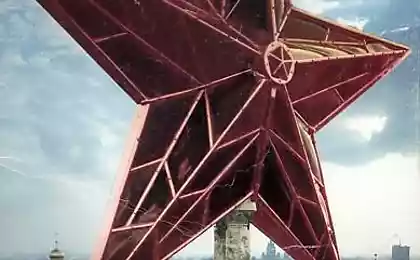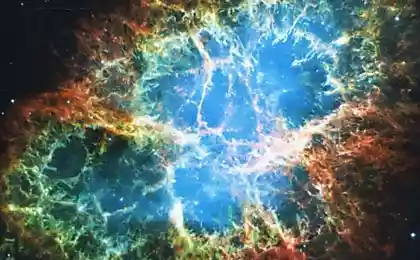1115
Happy birthday, star. Scientists 18 years watching the birth of a new star
957360
Giving birth is a process that lasts about 9 months. It seems like a long time. But star birth is a much longer process, lasting tens and hundreds of thousands (if not millions) of years. Earth scientists have been observing the birth of a star for more than 18 years. We are talking about W75N(B)-VLA2 in the constellation Cygnus, which is removed from Earth at a distance of about 4.2 thousand light years. The first image of the protostar was taken in 1996 and the last in 2014.
Observation of the protostar is conducted by scientists using radio telescopes. Even in 18 years, the star’s birthplace and the entire system have undergone significant changes. So, back in 1996, scientists saw a fairly small (on a stellar scale) region of ionized wind, which was ejected by the protostar in different directions at approximately equal distance. But the new images show the deformation of the ionized substance.

Specialists are going to observe the star and further, and observations are conducted in almost real time (as much as possible with such a removal). Astronomers are now observing an exceptionally unique event—star formation—beginning in its earliest stages.

Protostar VLA2 W75N (B)-VLA 2 is about 2 times heavier than the Sun. She is very young now – she is only a few thousand years old. Observations, according to experts, should help clarify how the formation and development of stars in the Universe. However, the star will be fully formed only in hundreds of thousands of years, so modern scientists will not be able to see the end of the process of formation of a newborn star.
Source: geektimes.ru/post/248558/
Giving birth is a process that lasts about 9 months. It seems like a long time. But star birth is a much longer process, lasting tens and hundreds of thousands (if not millions) of years. Earth scientists have been observing the birth of a star for more than 18 years. We are talking about W75N(B)-VLA2 in the constellation Cygnus, which is removed from Earth at a distance of about 4.2 thousand light years. The first image of the protostar was taken in 1996 and the last in 2014.
Observation of the protostar is conducted by scientists using radio telescopes. Even in 18 years, the star’s birthplace and the entire system have undergone significant changes. So, back in 1996, scientists saw a fairly small (on a stellar scale) region of ionized wind, which was ejected by the protostar in different directions at approximately equal distance. But the new images show the deformation of the ionized substance.

Specialists are going to observe the star and further, and observations are conducted in almost real time (as much as possible with such a removal). Astronomers are now observing an exceptionally unique event—star formation—beginning in its earliest stages.

Protostar VLA2 W75N (B)-VLA 2 is about 2 times heavier than the Sun. She is very young now – she is only a few thousand years old. Observations, according to experts, should help clarify how the formation and development of stars in the Universe. However, the star will be fully formed only in hundreds of thousands of years, so modern scientists will not be able to see the end of the process of formation of a newborn star.
Source: geektimes.ru/post/248558/























